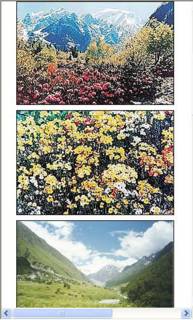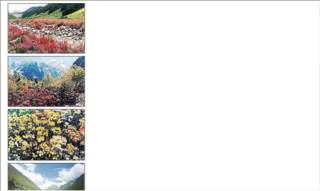The Valley of Flowers
IT is a Wordsworthean setting! Situated in a lonely corner, high in the Himalayan ranges of the Garhwal region in Uttaranchal, at a height of more than 3000 metres, the Valley of Flowers remains under a blanket of snow for almost six months a year, from October to March.
Hidden from the eyes of civilisation, this valley was known as the Bhyundar Valley, the playground of fairies and nymphs. Legends associate it with the area from where Hanuman collected the Sanjeevani herb to revive Lakshmana, the younger brother of Lord Rama.
The Valley of Flowers was first introduced to the world by Frank S. Smith, a representative of the Edinburgh Botanical Gardens in 1931. However, some believe that the Valley of Flowers was first seen accidentally by R.L. Holdsworth, botanist, but the actual exploratory work was done by Frank S. Smith who camped there for several weeks in 1937.
Smith authored a book called The Valley of Flowers, which unveiled the beauty and floral splendours of the valley. He described his experiences thus: "The wonders of this valley are its flowering plants. You find here different branches of same plant yielding flowers of different colours and varying fragrance. All these coupled with fauna combine to make a superb and harmonious ensemble."
The Valley of Flowers, which remains covered in snow from October to March, becomes accessible from late April onwards
In 1939, Margarate Legge, a botanist deputed by the Botanical Gardens of Edinburgh, arrived at the valley for further studies. While she was traversing some rocky slopes to collect flowers, she slipped off and was lost for ever in the Valley of Flowers. Her sister later visited the valley and erected a memorial on the spot where she was buried by the locals. The memorial is still there and the lines inscribed on the marble slab read:
"I will lift up mine eyes into the Hills from whence cometh my strength."
Rishikesh is the starting point for a journey to the valley. From here, buses and taxis are available for Joshimath, the main halting station at a distance of about 250 km. From Joshimath, one has to motor another 20 km to Govind Ghat, from where the trek starts. People coming from the east can travel from Haldwani to Nainital, Gwaldam, Karanprayag and then proceed to Joshimath.
The 250-km drive up to Joshimath is awe-inspiring. An important transit town, this place also has some ancient temples and other places of tourist interest. Reasonably good accommodation is available here.
The polygamous weed has been destroying the flora in the valley
The trek towards the valley begins at Govind Ghat after crossing the Alakananda river on a hanging bridge. This gurgling river was earlier seen at Rishikesh as the Ganga in all her serenity and majesty. Alakananda, here in her adolescence, is playful and sprightly. Crossing the left bank, the mule track immediately ascends in a zig-zag manner. Along the track you have a small tributary of the Alakananda river known as the Laxman Ganga. The waters of the Laxman Ganga are biting cold. The water of this rivulet has been channelised into a canal that feeds a small hydropower plant at Govind Ghat.
The zig-zag track suddenly straightens into a gradual climb through a valley of terraced fields and wild vegetation. The Laxman Ganga tumbles down to join the Alakananda. On the other bank of the Laxman Ganga is a range of rocky mountains. A number of trekkers and pilgrims take this route to visit Hemkunt Sahib.
A small rivulet from Bhyundar village, which opens to a picteresque valley, joins the Laxman Ganga. Far above, a snow-capped peak known as Hathi Parvat, looks down benignly on the valley. After resting here for a while, the trek to the Valley of Flowers continues through rich vegetation.
The Valley of Flowers is nearly six kilometres in length and two kilometres in width. The height at its entrance is 3352 metres and it goes up to 3656 metres at some places. At the entrance of the valley, a track emanates from Baman Dhaura on the right bank of a stream called the Pushpawati and goes on to a pass called Khantakhal at a height of 5440 metres.
The yellow-coloured pedicularis, grandiflora and ligularia lend a celestial touch to the valley in July and August
The Valley of Flowers is an alpine valley, and has been formed by the retreating glaciers whose periodic advances pulverised hard rocks, resulting in a smooth U-shaped valley which was later colonised by numerous plants. The valley remains covered by snow from October to April but when the ice melts in June, it gets invaded by a profusion of colours. Some important flowering plants which have tremendous medicinal value are anemone, geranium, marsh, marigold, primula, potentilla, aster, lilium, Himalayan blue poppy, delphinium, ranunculus, corydalis, inula, saussurea abvallata, campanula, pedicularis, trysimum, morina, impetienns, bistorta, ligularia, anaphalis saxifraga, lobelia, thermophis, trolises, aquilogia, codonopsis, dactylorhiza and rhododendron.
Apart from flowering plants, the valley abounds in wildlife like Himalayan birds, phigents, butterflies, tendula, musk deer, bharal (mountain goats), Himalayan bear and tailless rat. The Valley of Flowers is an irresistible treat for naturalists, ecologists, environmentalists, zoologists, ornithologists, trekkers, tourists and pilgrims.
The valley becomes accessible from late April onwards, when the snow starts melting and flowing down buttresses and gullies. The water pouring down the slopes provides appropriate moisture to the flowering plants. The moist turf begins to pulsate with life and from the dead herbage of the previous summer, innumerable shoots of countless plants rise expectantly as though in anticipation of the approaching monsoon.
Brahmkamal, a rare plant, is found in the valley
Primulas cover up slopes in the most heavenly shade of French blue. Their soft petals covered with dew emanate the sweetest of scents. In the lush meadows drifts of snow-white anemones drench the ground.
With the arrival of rains in June, balsam, geranium, pedicularis and many other species, mostly in pink and red, set the dominating colour pattern of the valley without subduing other seasonal shades of yellow, purple and white.
From late July to the end of August, the valley begins to take on celestial dimensions. The riot of colours is awe-inspiring. The pedicularis, grandiflora, ligularia and many other yellow varieties dominate the colourful scene. By September, the plants start podding and the valley dons tranquil shades of brown.
It is said that the root stock of almost all high altitude alpine flowers lie in and around the Valley of Flowers. The oak trees, blue pine and other conifers between Ghangria and the bridge on the Pushpawati are sometimes laden with ferns and tendrils hanging from their branches. The forests on the higher formations are full of birch trees, popularly known as bhojpatra whose bark was supposedly used to write on in ancient times.
Although the main valley is 4 km from Ghangria, flowers and foliage in exotic varieties can be spotted throughout the route. Immediately after crossing the Laxman Ganga, colonies of blue hackelia uncinata, commonly known as ‘forget me not,’ can be seen in the midst of shrubs and foliage along the roadside.Primulas, morinas, wild roses and many other species are found in abundance.
On reaching the banks of the Pushpawati, a rich formation of blue poppies, sun flowers, ligularia and pink andsosace can be seen between the rocky stretches near the bridge abetment. Further on, near the main valley, are gorgeous varieties of wild roses, rhododendron, geranium and the killer plant polygonum which has been offsetting the floral composition of the valley. A large variety of ferns like epiphytic, maidenhair and oak fern can be seen.
The valley is rich in herbal plants, many of these are flowering plants — bergenia, wood lily, trillium govanianum and marsh orchid are the popular ones. At several places, the dense growth of the flowering and non-flowering plants makes the valley look like a thick carpet that has been splashed with several colours.
A forbiddingly beautiful plant is arisaema costatum, popularly known as arum. Its head resembles that of a cobra. The plant grows in shady recesses, often in isolated family groups. Anemones, white dwarf rhododendrons, primulas and anaphalies give a white background to the valley. The violet iris kumaonesis, primula denticuleata in purple and potentillas in red, yellow and pink can also be seen.
Along the riverside there are small patches of land between scattered boulders, which have become the natural habitat of a majestic flower — the blue poppy. Known as meconopsis aculeata to botanists, it is a solitary flower and has the colour of the sky at dawn. Like most poppies, it is open and wide, droops slightly, has golden stamens, and is so fragile that its petals are detached merely by brushing against them. It protects itself with sharp spines arranged on the stem and buds.
The lily-like nomocharis oxypetala, a rare plant, blooms beautifully on the well-warmed, well-drained meadows of the valley. The rose-coloured cyprip edium himalaicum has earned the popular title of ‘lady’s slipper’ and there are a number of them in the valley.
The pinkish glow of the valley can be attributed to the large colonies of androsace, marsh orchid, geranium, pedicularis and thymus. Splashes of golden lily and creamy bell-shaped codonopsis are also seen. The pink pedicularis gives way to its yellow cousin — the mainstay of the August bloom. The potentillas are the first to appear and last to disappear from the valley.




















